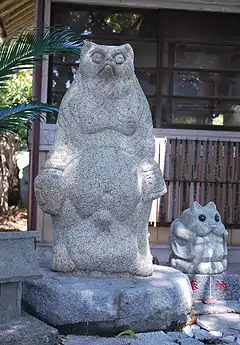Awa Tanuki Gassen
The Awa Tanuki Gassen (阿波狸合戦) (also called the Awa no Tanuki Gassen (阿波の狸合戦)[1] or the Kinchō Tanuki Gassen (金長狸合戦)[2]) is a Japanese legend that takes place in the Awa Province (now Tokushima Prefecture). The legend is about a great war between two tanuki powers.

There are several well-known tales about tanuki in Shikkoku,[3][4][5] and this one is said to be the most famous among those from Tokushima.[6] This story first appeared near the end of the Edo Period,[7] and in literature, it was first published in Meiji 43 (1910) under the title "Shikoku Kidan Jissetsu Furudanuki Gassen" (四国奇談実説古狸合戦).[8] It was a kōdan from the Meiji period until the time of the war and gained popularity in the beginning of the Showa period as it became depicted in movies. In the Heisei period, it has become a common theme in community development and is widely known in Tokushima Prefecture.
Legend
The story took place around the tenpō period (from 1830 to 1844) near Higaino in Komatsushima (now Higaino-chō in the city of Komatsushima, Tokushima). A dyer named Moemon (茂右衛門),[9] who ran a dyeing shop called Yamatoya (大和屋),[9] saved a tanuki who was being bullied by people.[10][11] Before long, Yamatoya's business was flourishing. Eventually, the tanuki came to serve as the guardian angel of Mankichi, who worked at the shop, and told of his origins. This tanuki was called Kinchō (金長) and he was chief of the local tanuki, aged around 206 years old. While around Mankichi, Kinchō performed great services such as curing customers' diseases and performing divination, gaining himself a great reputation.[10]
A few years later, Kinchō/Mankichi decided to try to raise his rank in society beyond that of a mere tanuki, so he became an apprentice to the bake-danuki, Rokuemon (六右衛門?), who lived in Tsuda Bay, Myōdō District. After much training, Kinchō displayed great accomplishments and almost achieved the rank of Senior First Rank. Rokuemon, loath to let go of Kinchō, tried to make him stay as a son-in-law through marriage to his daughter. However, Kinchō felt obliged to return to Moemon, and furthermore disliked Rokuemon's cruel personality, so he refused.
Unsatisfied with this, Rokuemon thought that Kinchō would eventually become his enemy and, together with a vassal, tried to assassinate Kinchō. Kinchō, with the assistance of a tanuki from Higaino named Fuji no Kidera no Taka (藤ノ木寺の鷹), counterattacked. However, Taka died in battle, and only Kinchō was able to escape to Higaino.
Kinchō attempted to recruit followers in order to take revenge for Taka, and started a battle with Rokuemon and his followers. In this battle, Kinchō's army won and Rokuemon was bitten to death, but Kinchō suffered mortal wounds and died afterwards before long.
It is said that Moemon, in regret for how Kinchō lost his life just before achieving the rank of Senior First Rank, went himself to Kyoto's priest at the Yoshida Shrine, and awarded him the title of Senior First Rank.[12]
Around the time of this battle, it was rumored that Kinchō's army was gathering at the Chinju Forest in preparation for battle against Rokuemon. When people entered the forest for sight-seeing, they heard much clamour and saw the footprints of a great number of tanuki, leading to speculation that the rumours of a battle were not simply lies or fairy tales.[10]
Variation

The exact story varies depending on the source, which is often seen to be the result of being influenced by a certain kōdan.[3]
- Rokuemon's daughter's name was Koyasuhime (小安姫). She was greatly in love with Kinchō, and criticized Rokuemon for trying to attack Kinchō, and finally committed suicide in an attempt to make him feel guilt. However, Koyasuhime's death only increased Rokuemon's hatred. Also, Kinchō, upon hearing the death of Koyasu who loved him, became more determined to bring down Rokuemon.[13]
- The battle took place around Katsuura River, Kinchō's and Rokuemon's army were both more than 600 tanuki, and the battle lasted for 3 days and nights.[13]
- Shibaemon-tanuki from Awaji Island also took part in the battle.[14]
- Despite receiving a mortal wound, Kinchō desperately returned to Higaino and told thanks to Moemon before losing his final strength. Moemon, moved by seeing this and how he lived, deified Kinchō as a daimyōjin (wisdom god).[15]
- On the verge of death, Kinchō became a spirit and served as Mankichi's guardian spirit, and swore to serve as a god for the Moemon family even after death, as an act of gratitude. Moemon, moved by this, deified Kinchō as a daimyōjin (wisdom god).[16][17][18]
- After Kinchō and Rokuemon's deaths, their sons started fighting in grief over Kinchō and Rokuemon, but Tasaburō-tanuki intervened and mediated, ending the war.[14]
Origin
In the years of Tenpō, there existed a tale about how a tanuki saved by Yamatoya repaid the favor as a sign of gratitude, leading to the theory that this story came from that tale.[19] In a certain year after that, there was an incident where a great number of tanuki corpses were found at the river banks of Katsuura River,[20] leading to the theory that the tale of the great clash between Kinchō and Rokuemon was born from people creating a "kōdan" (narrative story) based on these events.[19]
On the other hand, the kinds of battles, tragedies, and conflicts detailed in this war, being aspects of human society, can also be thought of as a depiction of events in human society with the people replaced by tanuki.[21]
In a spiritual mountain of the Tokushima's Shugendō practitioners, there was a battle between the different sects. In the legend called the Furudanuki Kinchō Giyuu Chinsetsuseki (古狸金長義勇珍説席), there was a scene of rock-throwing, and since rock-throwing was a military technique of the Middle Ages, there's the theory that the tale of the battle between tanuki was based on a battle between Shugendō practitioners on Mount Tairyūji and Mount Tsurugi.[22] In this theory, the Shugendō practitioners on Tairyūji would be based on Kinchō and the Shugendō practitioners on Mount Tsurugi would be based on Rokuemon, suggesting that it's related to a clash that erupted when different schools of Shugendō from two different bases, the ones from Mount Tairyūji trying to move north and the ones from Mount Tsurugi trying to move south, collided with each other.[22]
Tokushima Prefecture was also a place where aizome (Japanese indigo dyeing) thrived, which used sand in its process, and the sand that could be mined from Tsuda bay was the most suitable for aizome. This leads to the theory that the tanuki war was based on a battle for these sands between the two sides of the Katsuura River.[23] There's also a theory that it's based on a battle about fishing fights between Tsuda District and Komatsushima.[23][24] Asagawa Yasutaka, the chief priest of the shrine Tsuda-ji, where there's a landmark about Rokuemon, also supports this theory.[25] If one of these theories about this tale being based on human society is true, this would mean that it's actually a tale where the foolishness of humans have been projected onto the blameless tanuki.[23]
Regardless of the truth about the story of the tanuki, Shibaemon was a real person,[5][26] and the 1939 movie Awa Tanuki Gassen is based on a kōdan book as well as the oral legends told by a direct descendant of Shibaemon.[5] Also, there's the theory that the incident with Mankichi becoming protected by a tanuki was a separate event from the tanuki war, with later kōdan storytellers tying them together to create the "Awa Tanuki Gassen" tale.[22]
Related legends
According to legends in Tokushima Prefecture, during the times of the Awa Domain, the time drum (a drum for notifying about the time) was beaten, but the drum wasn't beaten within the city only at 4 o'clock in the Fujita Ōmichi area and at 6 o'clock in the Teramachi area. This is said to be because in a subordinate shrine to Fujita Ōmichi's Konpira Jinja, Kichō immediate descendant was enshrined as "Oyotsu-san" (meaning four), and in Teramachi's Myōchō-ji a female tanuki was enshrined as "Oroku-san" (meaning six), and a curse would arise if the drum was beaten at the same time as their name.[14] In another theory, it's because Rokuemon's (whose name begins with "six") immediate descendant was enshrined in Teramachi.[27]
Movies
- Awa Tanuki Gassen (1939)
- Awa Tanuki Yashiki (1940)
- Awa Odori Tanuki Gassen (1954)
- Awa Tanuki Henka Sōdō (1958)
- Heisei Tanuki Gassen Ponpoko (1994)
References
- 井上 1980, p. 202.
- "新八狸・四国昔話八十八ケ所巡り". ku-kai.org ウェブサイト空海]. [セント・レディス]. 2006. Retrieved 2015-09-03.
- 横山 2009, pp. 18–24
- 内藤ほか 2007, pp. 182–183
- "たぬきのまちづくり" (PDF). 小松島市. Archived from the original (PDF) on 2011-06-12. Retrieved 2013-06-18.
- 村松定孝 (1990). 新・日本伝説100選. 100選シリーズ. 秋田書店. pp. 216–218. ISBN 978-4-253-00406-0.
- 斉藤ほか 2006, p. 84
- "妖怪散策 語り伝えられる狸合戦". 読売新聞 大阪朝刊. 読売新聞社. 2005-10-16. p. 28.
- 谷野圭助 (2008-11-25). "金長さん". 徳島新聞. 徳島新聞社. Archived from the original on 2012-11-15. Retrieved 2015-09-01.
- 笠井 1927, pp. 95–102
- 多喜田 2009, pp. 117–119
- 横溝ほか 1989, pp. 360–361
- 武田他 1977, pp. 177–185
- 後藤 1922, pp. 281–288
- 三澤敏博 (2005). 日本もののけ奇譚. 白地社. pp. 84–85. ISBN 978-4-89359-230-9.
- 井上 1980, pp. 123–125
- "たぬきの民話・伝説". 小松島市. 2009-08-01. Archived from the original on 2012-08-25. Retrieved 2013-06-17.
- "金長たぬき". [renkeijiku.net 西日本中央連携軸へようこそ。]. Archived from the original on 2007-11-10. Retrieved 2013-06-17.
- 桂 1994, p. 13
- 報知新聞社 2009, p. 21
- "阿波狸合戦(下)小松島市". 徳島新聞. Archived from the original on 2015-03-26. Retrieved 2015-09-01.
- 中村 1998, pp. 275–280
- 高橋 2000, pp. 235–238
- 三輪 2010, p. 31
- 徳島新聞 2011a, p. 27
- "コラム 金長神社". 中国四国農政局. Retrieved 2013-06-17.
- 宮田登 (2006). 王権と日和見. 宮田登 日本を語る (in Japanese). 吉川弘文館. p. 189. ISBN 978-4-642-07142-0.
Sources
- Awa Tanuki Gassen at Google Books (German)
- 井上友治 (May 1980). 狸と日本人. 黎明書房. NCID BN06991060.
- 笠井新也 (August 2009) [1927]. 阿波の狸の話. 中公文庫. 中央公論新社. ISBN 978-4-12-205193-5.
- 後藤捷一 (July 1922). "阿波に於ける狸傳説十八則". 民族と歴史. 日本学術普及会. 8 (1号(通巻43号)). NCID AN00237313.
- 斉藤小川町ほか (October 2006). 人文社編集部編 (ed.). 日本の謎と不思議大全. ものしりミニシリーズ. Vol. 西日本編. 人文社. ISBN 978-4-7959-1987-7.
- 高橋晋一 (January 2000). "「はなし」の社会的機能 阿波の狸話をめぐって". 世間話研究. 世間話研究会 (10). NCID AA11578391.
- 多喜田昌裕 (April 2009). "阿波狸合戦の真実". In 力石幸一編 (ed.). 不思議大陸アトランティア. TOWN MOOK. Vol. 1号. 徳間書店. ISBN 978-4-19-710208-2.
- 武田明・守川慎一郎 (March 1977). 阿波の伝説. 日本の伝説. 角川書店. NCID BN03653571.
- 戸部民夫 (12 January 2013). 神様になった動物たち. だいわ文庫. 大和書房. ISBN 978-4-479-30417-3.
- 内藤浩誉ほか (December 2007). 日本口承文芸学会編 (ed.). シリーズことばの世界. Vol. 第3巻. 三弥井書店. ISBN 978-4-8382-3160-7.
- 中村禎里 (March 1998). "徳島県のタヌキ祠". In 沼義昭博士古稀記念論文集編集委員会編 (ed.). 宗教と社会生活の諸相. 隆文館. ISBN 978-4-89747-338-3.
- 村上健司 (25 August 2008). 日本妖怪散歩. 角川文庫. 角川書店. ISBN 978-4-04-391001-4.
- 横山泰子 (October 2009). "狸は戦い、舞い踊る". In 小松和彦編 (ed.). 妖怪文化研究の最前線. せりか書房. ISBN 978-4-7967-0291-1.
- 横溝正道ほか (August 1989). 全国神社大要覧. 大竹伸宜監修. リッチマインド出版事業部. NCID BN04522127.
- 桂冨士郎 (17 April 1994). "阿波文学散歩". 徳島新聞 (in Japanese) (朝刊 ed.). p. 13.
- "徳島県小松島市 タヌキの町を愉快にアピール". スポーツ報知 (in Japanese). 報知新聞社. 21 April 2009. p. 21.
- 三輪さち子 (31 January 2010). "徳島市津田西町かいわい タヌキ総大将、いま神様". 朝日新聞 (in Japanese) (大阪地方版 ed.). 朝日新聞社. p. 31.
- 吉松美和子 (22 September 2011a). "津田の狸伝説 六右衛門の魅力". 徳島新聞 (in Japanese) (朝刊 ed.). p. 27.